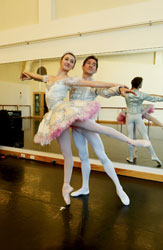 Ballet is of course the most completely romantic of the arts, and two dancers new this season to the Louisville Ballet roster seem to incarnate the romantic spirit in their slender forms. They are Phillip Velinov and Natalia Ashikhmina — he Bulgarian, she Russian — and the stories of their separate career paths — the political storms they rode to come to
Ballet is of course the most completely romantic of the arts, and two dancers new this season to the Louisville Ballet roster seem to incarnate the romantic spirit in their slender forms. They are Phillip Velinov and Natalia Ashikhmina — he Bulgarian, she Russian — and the stories of their separate career paths — the political storms they rode to come to
The normally restrained Bruce Simpson, artistic director of a resurgent Louisville Ballet, can barely hold back his glee as he contemplates the contribution these two gifted artists will make to his company. Put briefly, he says, “They will add an Eastern European flavor to an already eclectic mix of dancers.” This winter and spring Louisville Ballet audiences will have several opportunities to see the pair in action, beginning with Uncharted Realms in February through the final production of the season, Sleeping Beauty, in April.
The fall of the Iron Curtain was the defining political event of the late 20th century, and one that opened up opportunities for young Eastern European artists in ways we in the West can hardly grasp. Ashikhmina seized these opportunities. The combination of extraordinary natural gifts of musicianship, grace and strength, allied with the rigorous training that characterizes the Russian tradition, enabled her to make the journey from rural
She has the reserved dignity of the best of her breed. Her innate modesty and quiet charm — hampered or enhanced, depending on your view, by her halting English — are immediately captivating. Her husband interprets for her, leaning in toward her in a tender, solicitous way as she tells of winning a place at the Moscow State Ballet, where she quickly rose to the status of prima ballerina. A complicated and serendipitous tale of her photograph being featured on a ballet calendar that somehow ended up in Indianapolis, where it was spotted by the then-artistic director of Ballet Internationale, explains how she made the leap from Russia to the Midwest. Prior to that she had won international acclaim on three continents — as the saying goes — dancing the great roles of the ballet repertoire: Odette/Odile in
She is hesitant when questioned about why she would exchange the hub of Russian culture for the hubcaps of
While it might seem rude to knock the fountainhead of the art, the glorious technical tradition of Russian dance is seldom reflected in repertoire and production values. Too often a gifted dancer — maybe a great Giselle — is condemned by the system to dance little but Giselle over a 25-year career. Sets often look as if approved by Joseph Stalin and the Politburo and the costumes modeled by Mrs. Khrushchev. Ashikhmina is more diplomatic: “It is very difficult to create within such a traditional system,” she says.
The fall of Communism also created some doubts about the future. “Things have changed, for the better and the worse,” Ashikhmina says. “There is less security for dancers, but some broadening of the repertoire.” State subsidy is now reduced or non-existent, so the big and famous companies like the Kirov and the Bolshoi have engagements up to a decade in advance because of their ability to earn foreign currency, but, she says “the smaller, poorer companies have to struggle.”
Velinov’s progress from Eastern Europe to
Here, art and politics intertwine, because he was a lad of 16, exactly the right age, when the Iron Curtain fell. The famed Kirov Ballet has a school in
In the /files/storyimages/he did not study in
Eventually, the two storm-tossed dancers met up at Ballet Internationale. Velinov had been in
When the board of Ballet Internationale responded to a financial crisis by gallantly pulling the plug on the company, Velinov says, “it was a total shock, an absolute surprise. It came with an hour-and-a-half notice. November 9, 2005. We had just come back from our honeymoon.”
Bruce Simpson was able in due course to bring the pair (by now a trio, including Gabriella) to
One of the joys of a ballet career is also a potential disadvantage — that someone can go from ballet school as a young child, through the training process and on to stardom all in one company. Many dancers never get to experience the great traditions, especially the Russian traditions, of their craft. Just being in class with Ashikhmina gives her colleagues at Louisville Ballet a taste of the international.
Simpson reminds us that the repertoire of the Louisville Ballet is eclectic. A recent program ranged from the classical formality of Raymondo Act III through the modern severities of a Balanchine classic, Agon, to Twyla Tharp’s witty settings of Nine Sinatra Songs — a range of styles that dazzles the mind, but one his dancers are expected to embrace and interpret with total stylistic versatility. So a special concern for the artistic director is to be a guardian of the sacred flame of the classical tradition, and in ballet the Russian tradition is one of the major forces.
The first production ever in which the couple danced together was Raymondo Act III in November. “It makes it easier,” Velinov says. “Every married couple has an unspoken language; there is no ice to be broken. She has taught me much.”
Simpson — who we suspect is, like so many holding his title, really a closet opera fan — employs a vocal metaphor to describe Velinov’s special gifts and therefore special role in the company. “Phillip is a tenor — a lyric tenor,” he says. He has a light frame and a flowing grace allied to the required physical strength. He lifts his partner aloft, but also sets her down with an ease of motion.
The life of a dancer is hard and disciplined, and for this couple involves balancing strenuous practice and rehearsal schedules with the demands of homemaking and child-rearing. But this is not apparent as they discuss the special joys of working together and being partners in a very real and intimate sense, the pleasures of “bringing work home” as they share and discuss how the day’s rehearsal went. To the inevitable question of what they will do when they can no longer dance, Ashikhmina has a suitably fatalistic old Russian proverb handy: “If you would like to amuse God, tell him of your plans.”
Contrary to the mythology, dancers can, if they choose and are lucky, enjoy long careers — far longer than the athletes with whom they invite comparison. Bruce Simpson danced professionally until he was 50; the legendary Dame Margot Fonteyn retired at 62. Most professional footballers and basketball players, though, retire in their mid-30s, and often earlier.
“But then,” says Velinov, a touch ruefully, “they can afford to retire at 35.”


